How To Set Up A Litter Box
Our mission is to assist salvage dogs' and cats' lives through our educational content. To support our efforts, this page may incorporate affiliate links. We earn a commission for qualifying purchases – at no cost to yous.
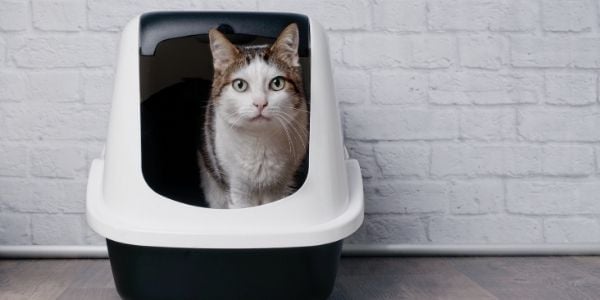 In "Litter Box 101: How to Choose the Best Litter Boxes for Your Cats and Why Y'all Demand To," I gave some pointers for choosing the best litter boxes for your cats.
In "Litter Box 101: How to Choose the Best Litter Boxes for Your Cats and Why Y'all Demand To," I gave some pointers for choosing the best litter boxes for your cats.
Now I'thousand going to show y'all how best to set up and maintain your cat's boxes.
Follow these tips, and you'll exist able to avoid mutual litter box bug, similar wayward peeing and pooping outside the box, and you'll also exist prepared to identify painful or potentially life-threatening conditions.
You Need More Litter Boxes Than You Might Recall
Why would ane cat need more than than one box? Because there are a ton of factors that might cake their access to a single litter box and other things that tin cause them to develop a stressful or painful association with it. If you've only given your cat a single, lone option, it's not going to exist proficient for either of you lot (this is a polite way of saying that they'll observe somewhere else to do their business or suffer from a painful tour of constipation or even urinary obstruction). Then, try to adhere to the "n+1 rule" for cat litter boxes by providing 1 more litter box in your dwelling than the number of cats you have.
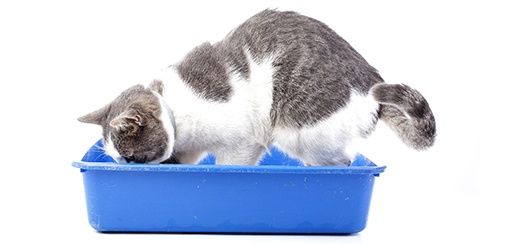
BTW, this box is a bit too small for this cat.
Check out our article on how to choose the right litter box for your kitty.
Where to Put Your Cat's Litter Boxes
When information technology comes to litter box placement, your true cat actually wants you to call up the 3 "L"s: location, location, location!
The Best Places for Litter Boxes
- Easy admission and exits: Ideally, your true cat should have at least two ways to get to and from each box. This is to keep their box from becoming completely blocked (e.m., by the family unit dog, a keen true cat, a closed closet door, etc.). If they can't go to or away from their box reliably, they're not likely to use it reliably.
- Plenty of space between: Fifty-fifty if yous have the right number of boxes, it'south just equally important to spread out your cat's litter boxes to prevent problems. I shudder each time I run into a dwelling with the right number of boxes, only they're all lined up in a row in the same room (close, but no cigar). It's all-time to spread the litter boxes beyond different rooms, and definitely accept at to the lowest degree one litter box on each floor of your dwelling. But if the boxes absolutely have to be in the aforementioned room or expanse, exist sure to provide enough of space between them.
- Skillful air apportionment: Your cat's nose is quite sensitive, and cramming their litter box in a small cupboard or a dingy basement is probable to force them to bargain with scents and odors that could stress them out and dissuade them from using their box. (Learn about other ways to reduce litter box odors.)
What to Avoid When Placing Litter Boxes
-
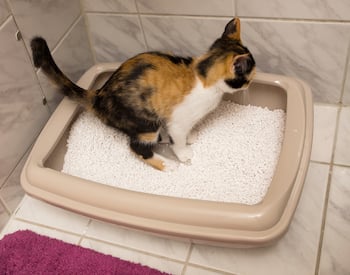 Drafty vents: Heating and air workout vents tin create unpredictable (as far every bit your cat's concerned) drafts of air that tin can startle and stress out your cat. Try to avoid locating their litter boxes near such vents.
Drafty vents: Heating and air workout vents tin create unpredictable (as far every bit your cat's concerned) drafts of air that tin can startle and stress out your cat. Try to avoid locating their litter boxes near such vents. - Foot traffic: If your true cat has to cope with the possibility of a bunch of people walking (or running, especially if you lot've got small children in your home) past their loo every fourth dimension they've got to go, it definitely won't be comfy or fun for them. Effort to discover a place that doesn't become as well much foot traffic.
- Noise: Going to the bathroom is a fairly vulnerable scenario for cats, and they can often exist on "high alarm" when in their box. If they're doing their business in an area where there'due south a lot of noise — especially if the noise is loud or sudden — then your cat isn't going to be able to go in peace. Though laundry rooms are common places for people to put their cat's litter boxes, the noise from a clunking clothes dryer or the end-of-cycle alarms from either machine can exist enough to stress out your true cat when they're feeling exposed. Try to avert the laundry room if you can.
Bonus Tip: Try Pheromones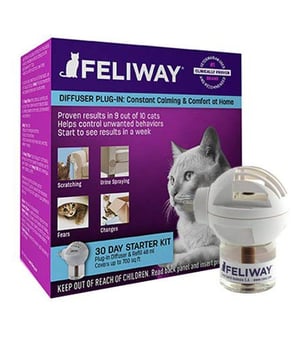
To aid your true cat unplug, endeavour plugging in. More than to the point, consider plugging in a Feliway calming pheromone diffuser near your cat's litter boxes. The Feliway calming pheromones can help reduce or prevent stress and anxiety in cats and — since stress and anxiety tin can be a common contributing factor in urinary problems with cats — prevent problems from ever happening in the commencement identify.
How Much Litter You Should Use and What Type
Filling your cat'due south litter boxes is generally straightforward, but there are a few things you lot should know to help get the right setup for your true cat.
- The type of litter: Offset, of course, you've got to choose your cat's litter. Given all the options and cool marketing buzzwords out there, I've dedicated an entire article to help you lot find the litter that's all-time for your particular cat. Check out "Litter Box 101: What Type of Litter is Best for Your Cat." But, mostly speaking:
- cats tend to prefer fine particle litters to large pellets
- avoid scented litters
- avoid irritating your cat's sensitive nose and lungs, utilise a low-dust litter
- How much litter to use: The right depth of litter for your cat's box will depend on their preferences and digging habits, your scooping habits, and the blazon of litter yous're using. You could get away with an inch or two in the box for cats that don't do a ton of digging if you're diligent with scooping multiple times per day and if the litter clumps up solidly and quickly. But those are ideal litter box maintenance conditions, and fifty-fifty then, ane–2" of litter might not exist enough. To play it safe, I recommend starting with 2–3" of litter in each box and and so adjusting as needed and always replenishing to maintain that depth.
- You might consider a litter attractant: For kittens who are but learning to use their litter boxes, you may want to add a flake of litter box attractant, such as the True cat Attract Litter Additive linked below. This condiment may also be useful in helping a previously litter-box trained true cat to fall back in love with their litter box — but with these guys, it's as well important to accept them checked out by your veterinarian to ensure that there isn't a medical reason that caused them to abandon their litter box in the start place.
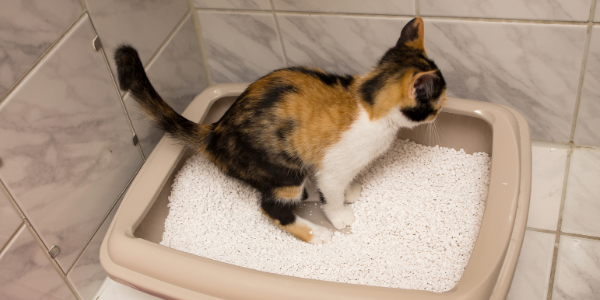
How to Maintain and Monitor Your Cat's Litter Boxes
The importance of scooping the "deposits" — both urine and stool — out of your cat'southward litter boxes at least one time daily truly cannot be overstated. Multiple studies have shown that cats routinely and strongly prefer clean litter boxes to those with "stuff" already in them. After all, would you lot adopt to apply a freshly flushed toilet, or by and large full porta potty?
A note near "self-cleaning" litter boxes: Enough cats are terrified of the noise and movement these things make to recommend against their utilise. Add to that the importance of actually seeing the trends in what your cat is putting out — which "self-cleaning" boxes deprive you of — and you tin see why I'one thousand not typically a big fan of these types of automatic boxes.
Wash, Rinse, Echo
To avoid the buildup of caked-on litter, fecal affair, and bacteria, try to do a complete litter box launder and refill nigh once a month. Apply lather and water to clean the boxes but do not employ bleach or other harsh cleaners. The odor of bleach and other chemicals tin can crusade your true cat to avoid their box fifty-fifty after it'southward clean. To finish up, dry the boxes and add fresh litter. Depending on the number of cats you take and how stinky and messy they are, you may need to exercise complete litter change-outs in-between these monthly litter box washings or launder the litter boxes more frequently.
Proceed an Heart Out
Changes in your cat'due south urinations and/or defecations tin can be some of the clearest signs of certain diseases and other medical or behavioral conditions. This is why information technology's and then of import that you monitor the number and size of the urine clumps and fecal deposits in your cat's litter boxes each 24-hour interval when you scoop them.
If you notice changes in your cat's litter box, here are some potential causes:
- Urine: more clumps/larger size
- Diabetes
- Hyperthyroidism
- Kidney failure (early on)
- Kidney infection
- Urine: fewer clumps/smaller size
- Impending urinary obstruction
- Float inflammation ("cystitis")
- Bladder infection
- Dehydration
- Your cat might also be peeing outside of their box
- Fecal: more stool/larger size/looser
- Change in nutrition
- Intestinal infection
- Abdominal worms
- Pancreatitis
- Food allergy
- Fecal: fewer stool/smaller size/more firm
- Constipation
- Aridity
- Digestive obstruction
- Your cat might likewise be pooping outside of their box
Avoid Actual Toilet Grooming
Lastly, I want to make a quick annotation about training your true cat to use a human toilet: don't practice information technology.
You might not be thrilled about the prospect of scooping your cat's litter box or any aspect of having a litter box in your home, but before you call up about toilet training your cat, take a moment to consider the consequences. I've outlined several of import (and hopefully compelling) arguments against toilet preparation in "vii Reasons Non to Toilet Railroad train Your Cat."
Source: https://www.preventivevet.com/cats/how-to-set-up-your-cats-litter-boxes-to-prevent-potty-accidents

0 Response to "How To Set Up A Litter Box"
Post a Comment